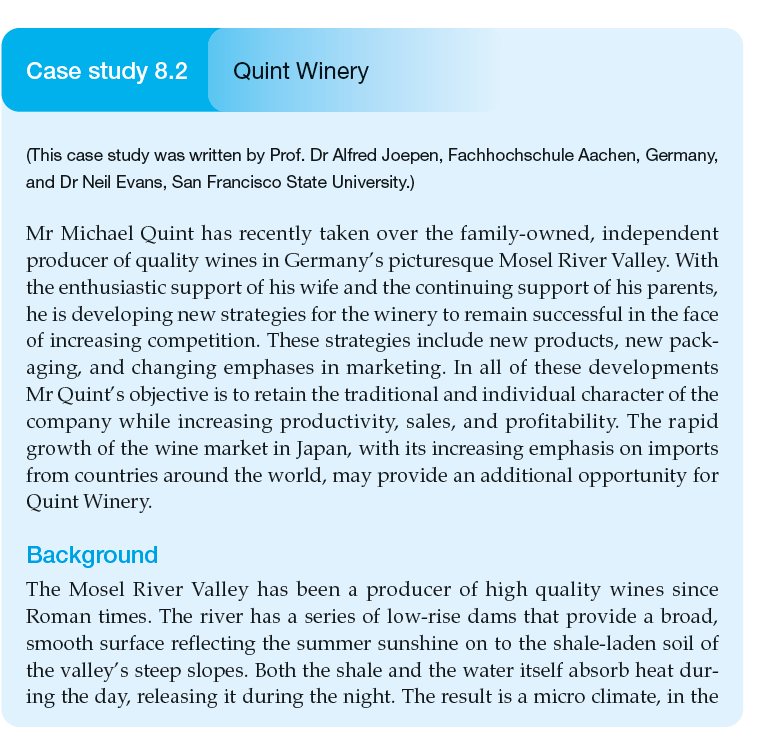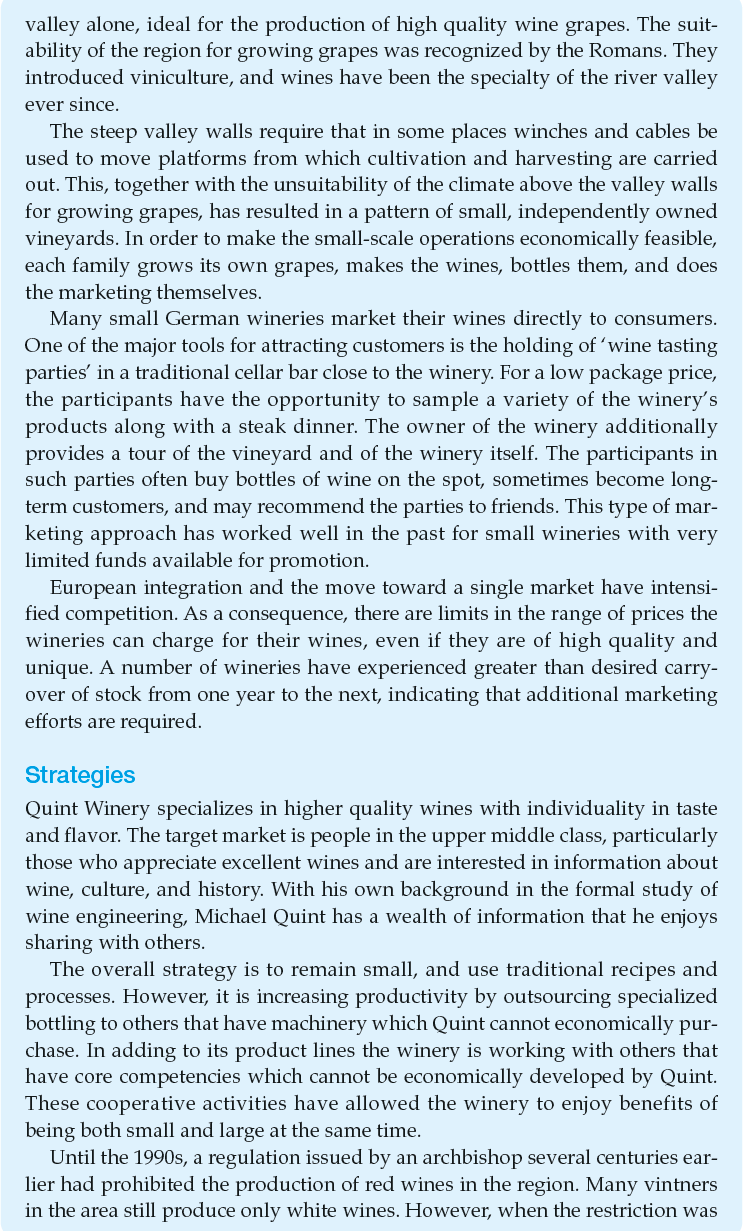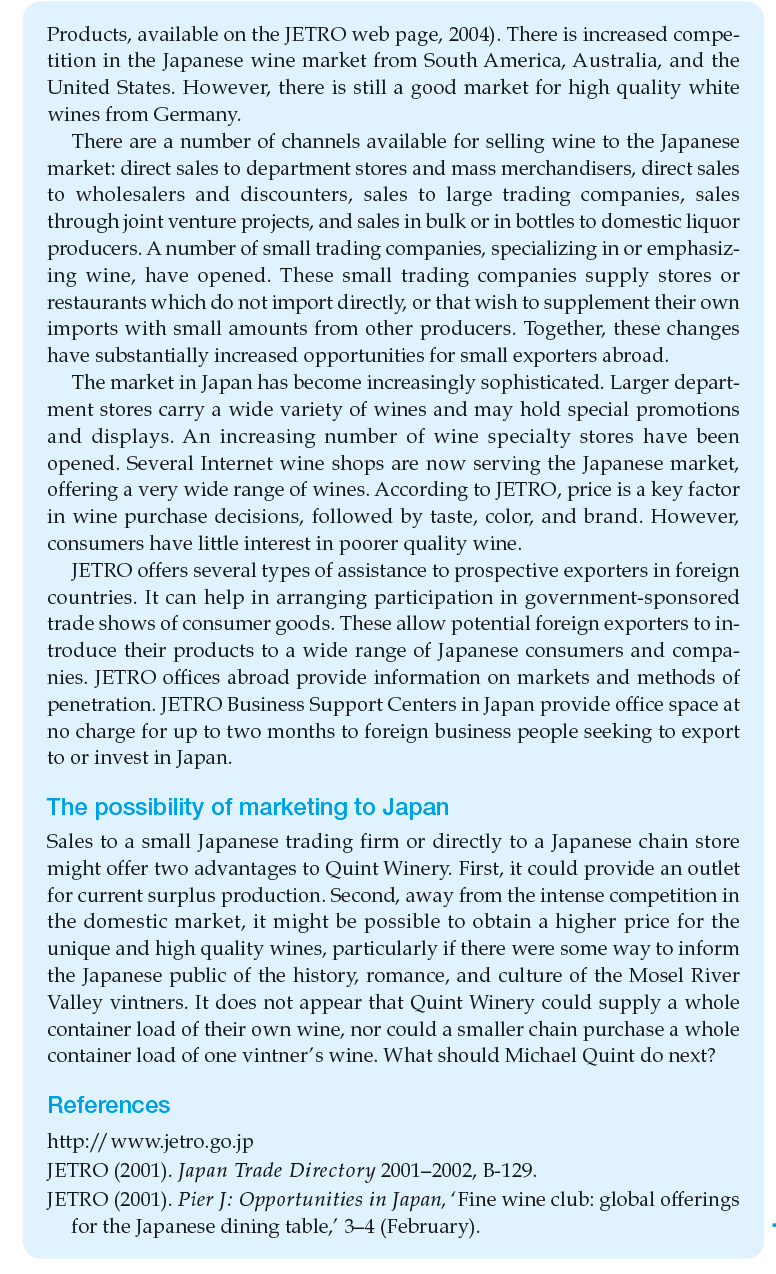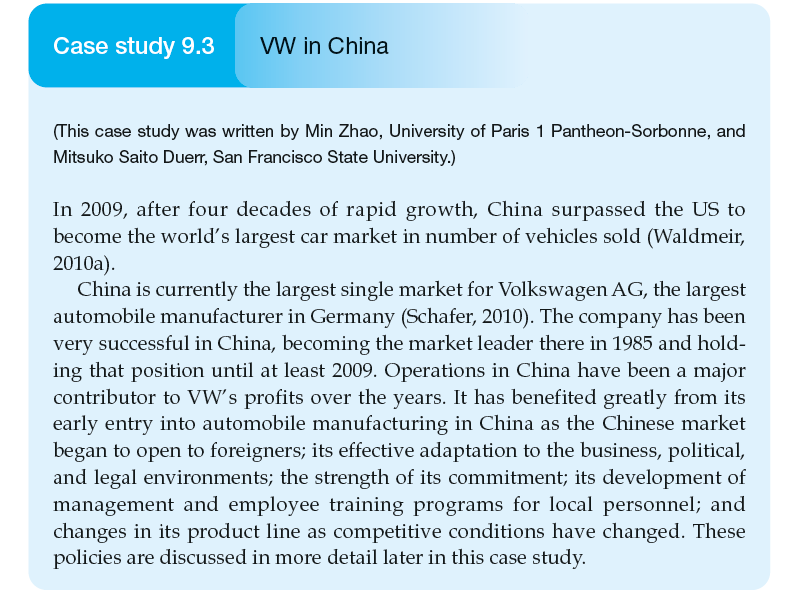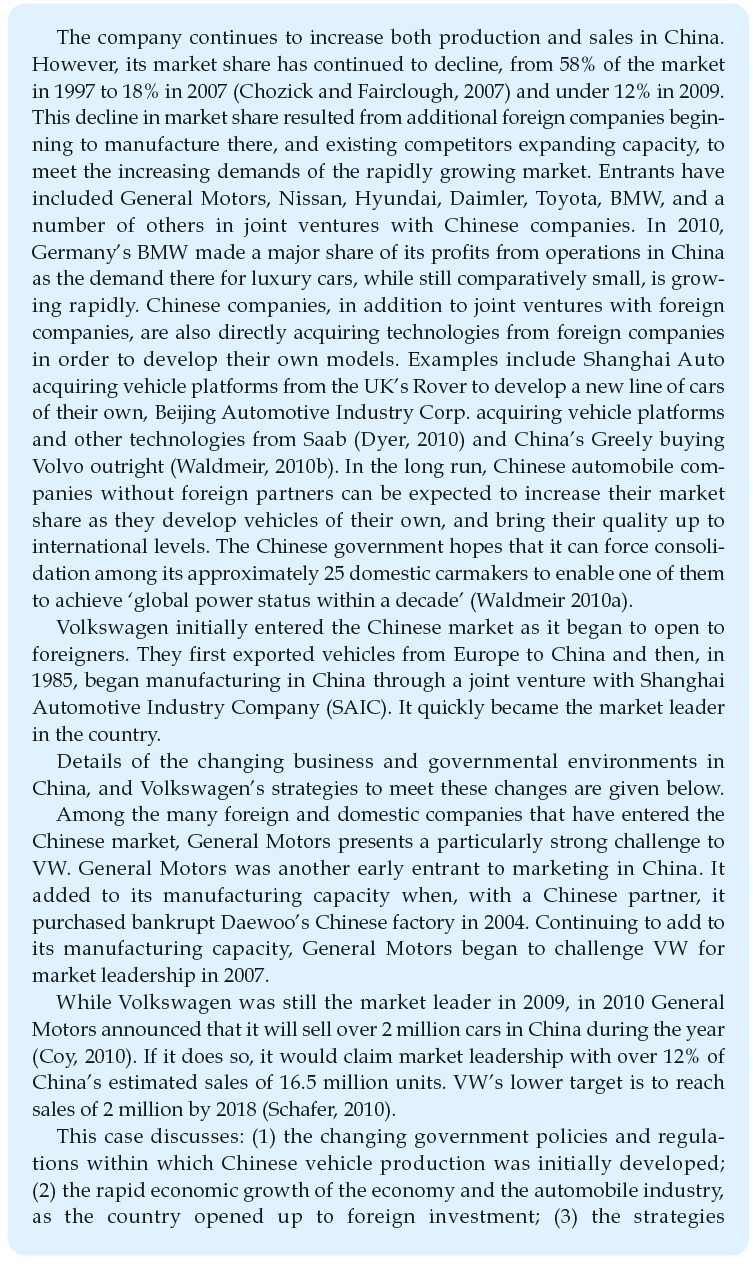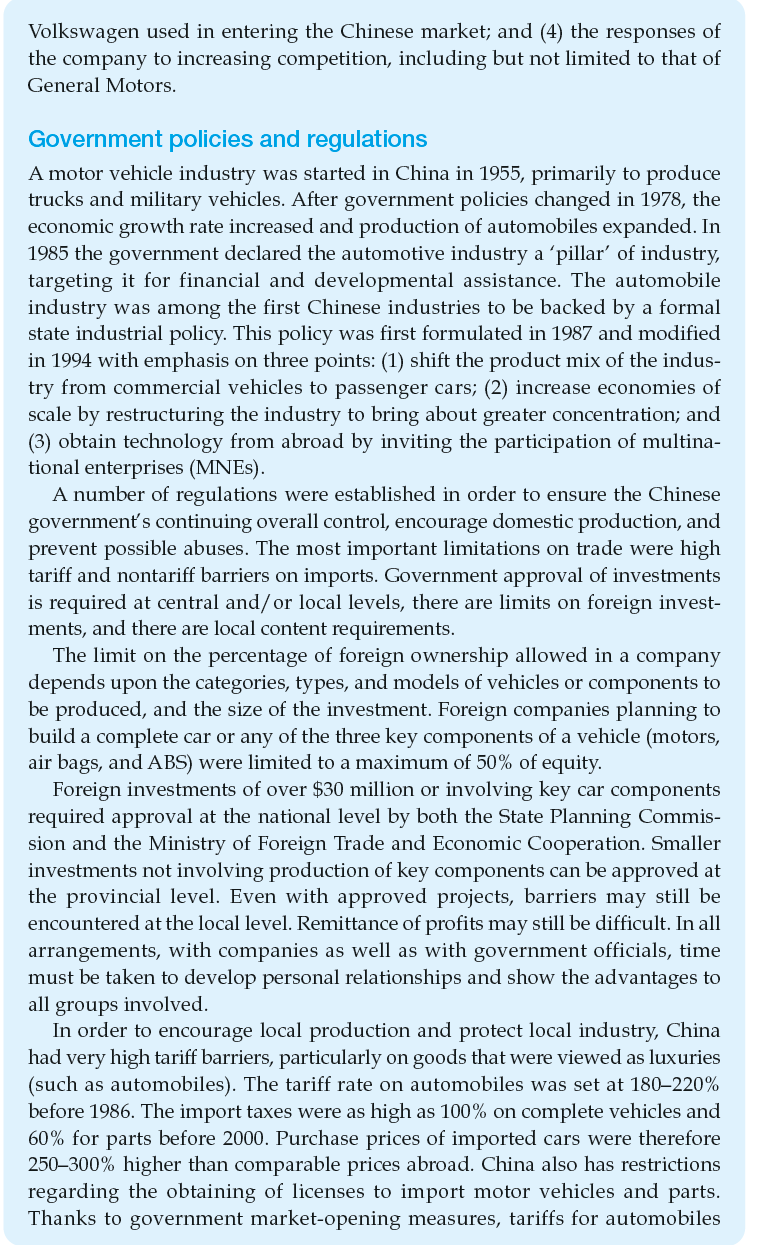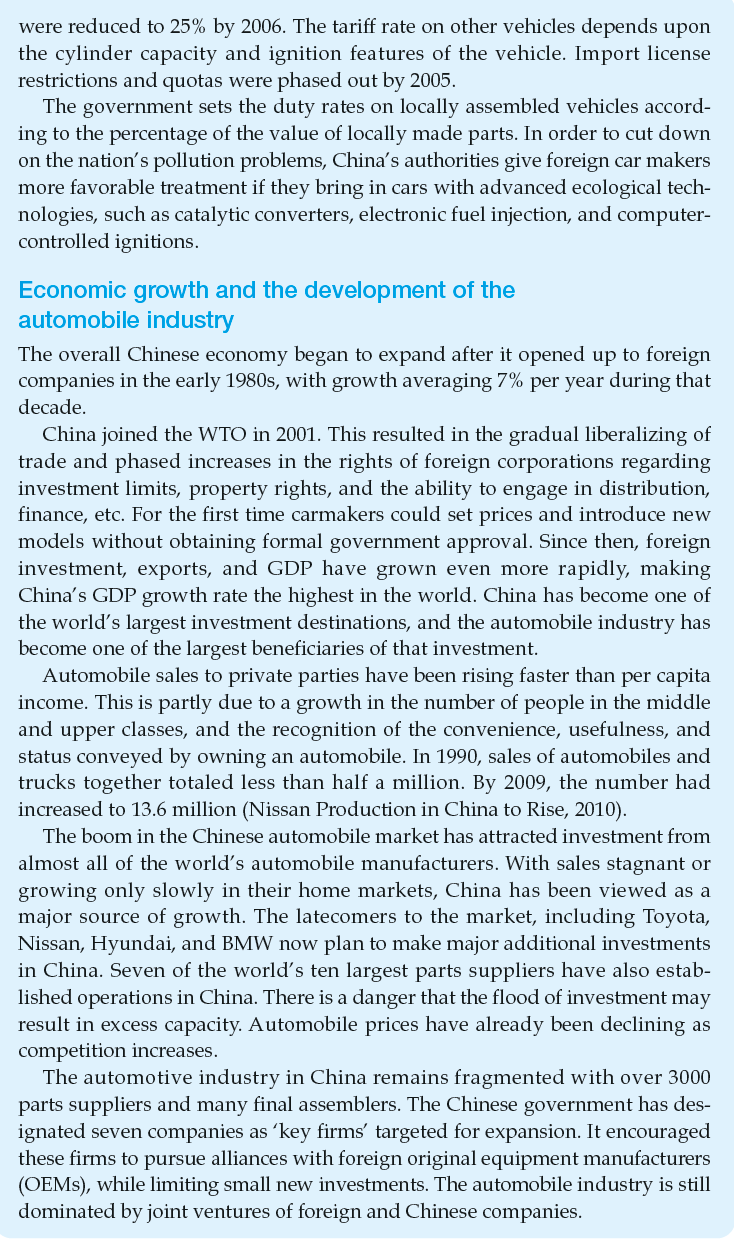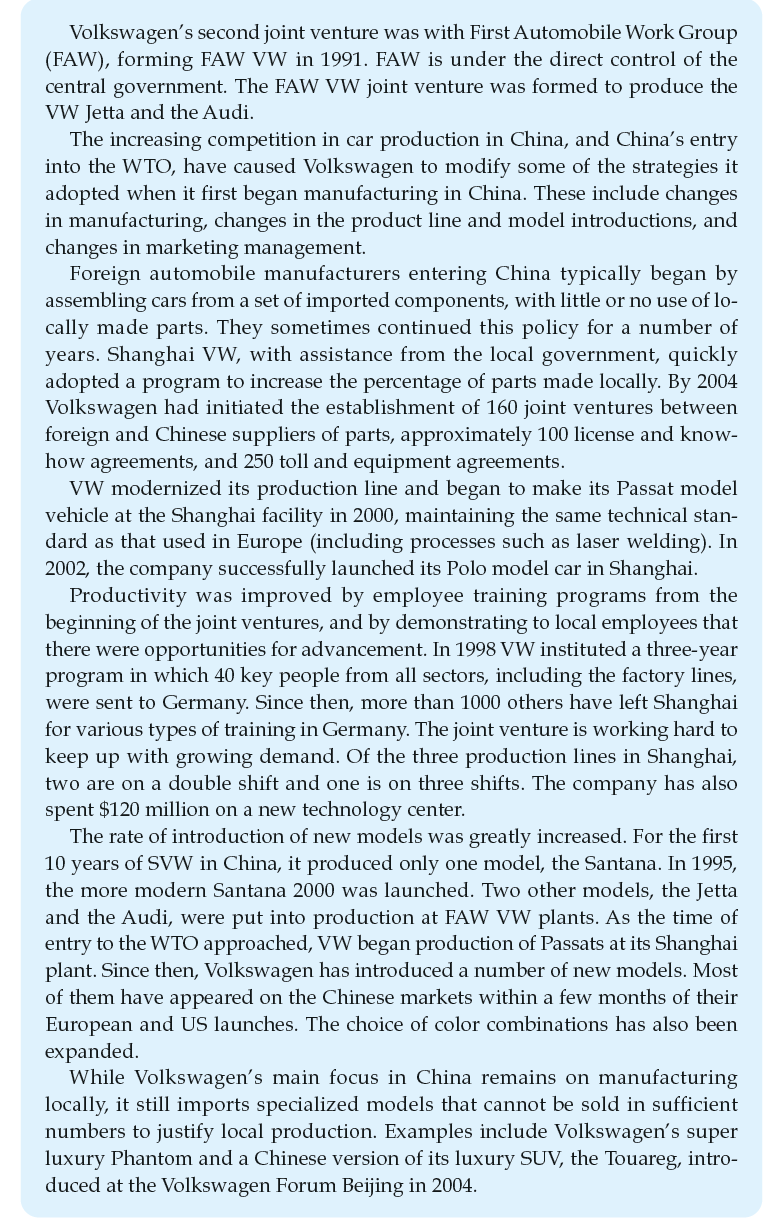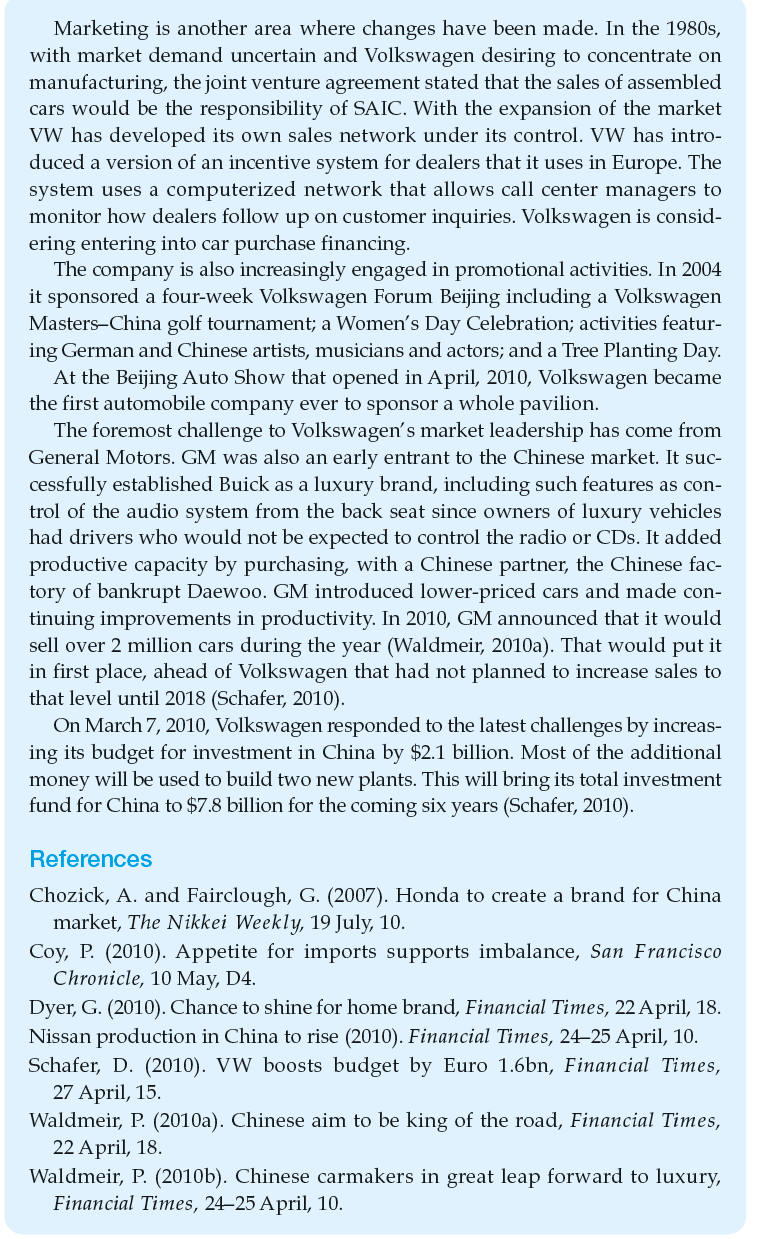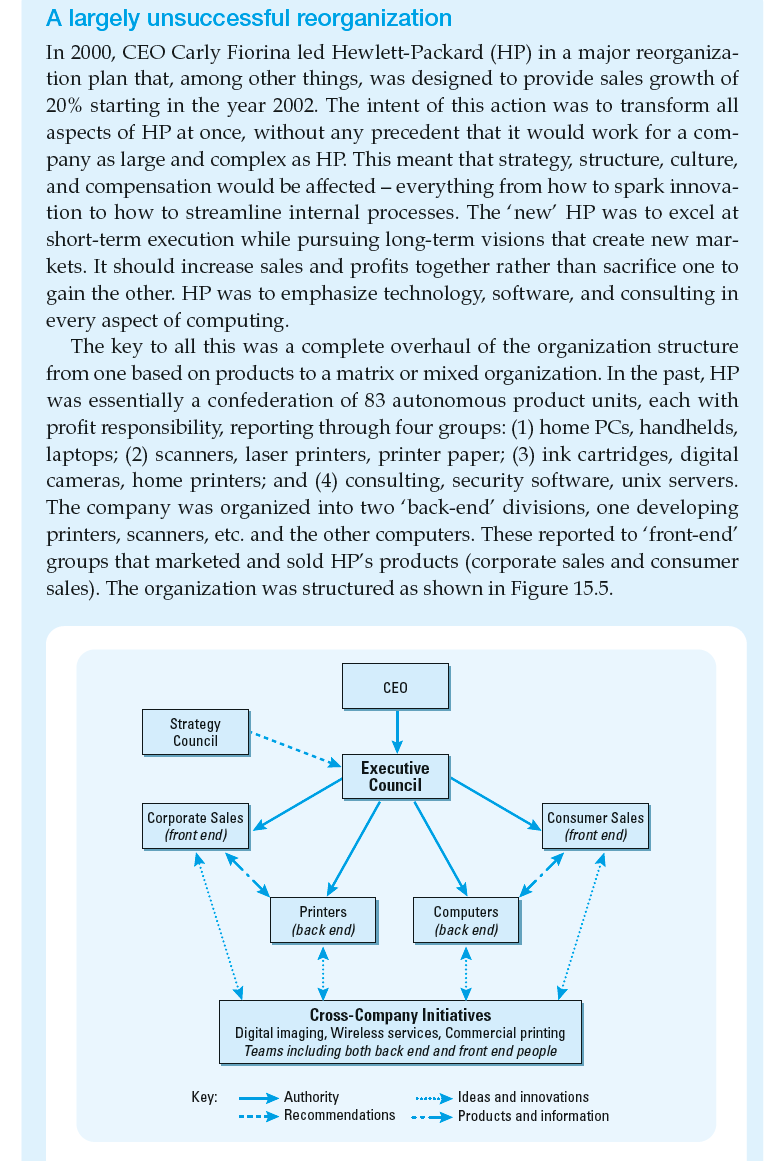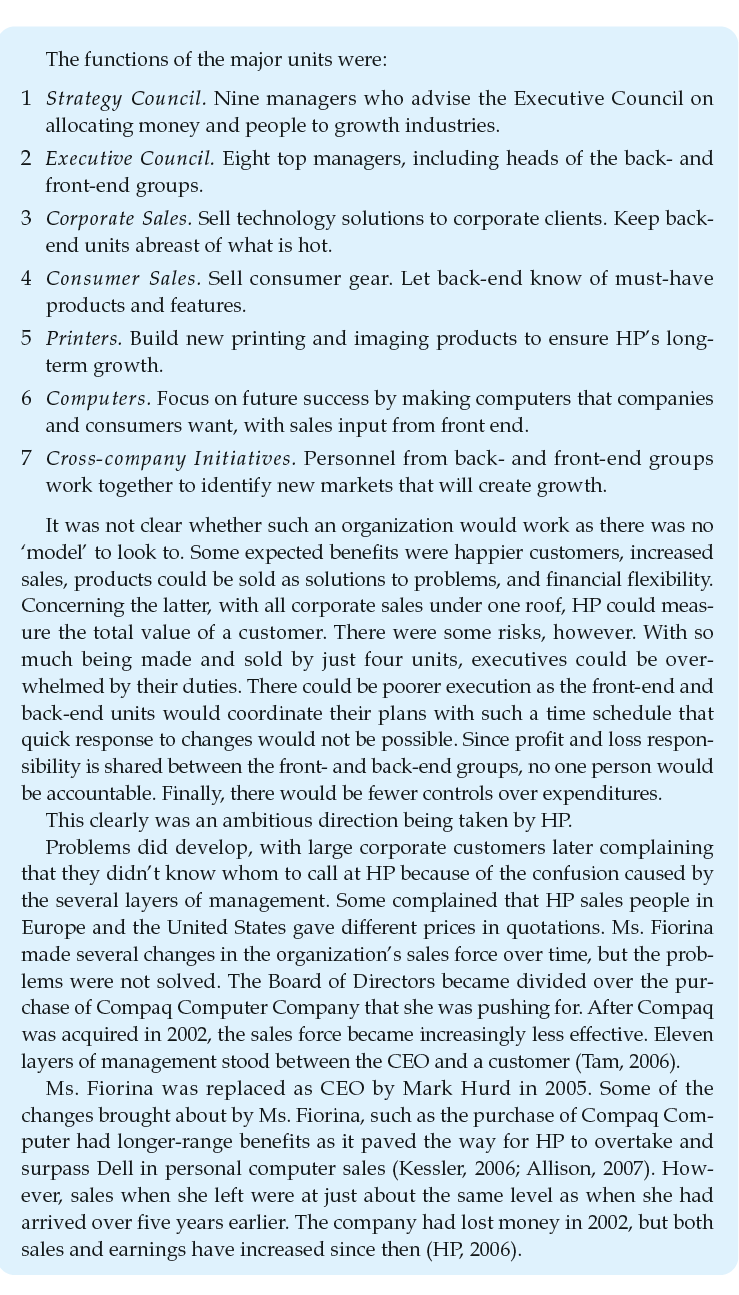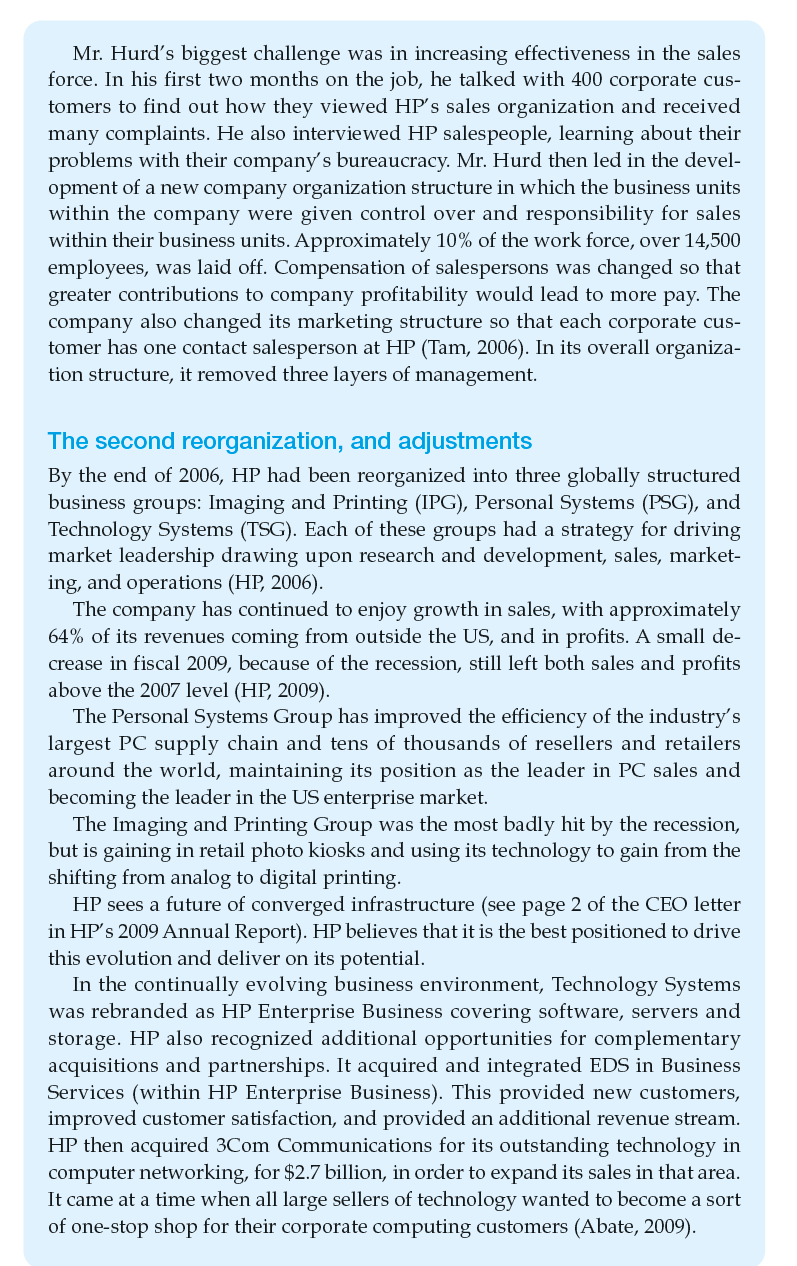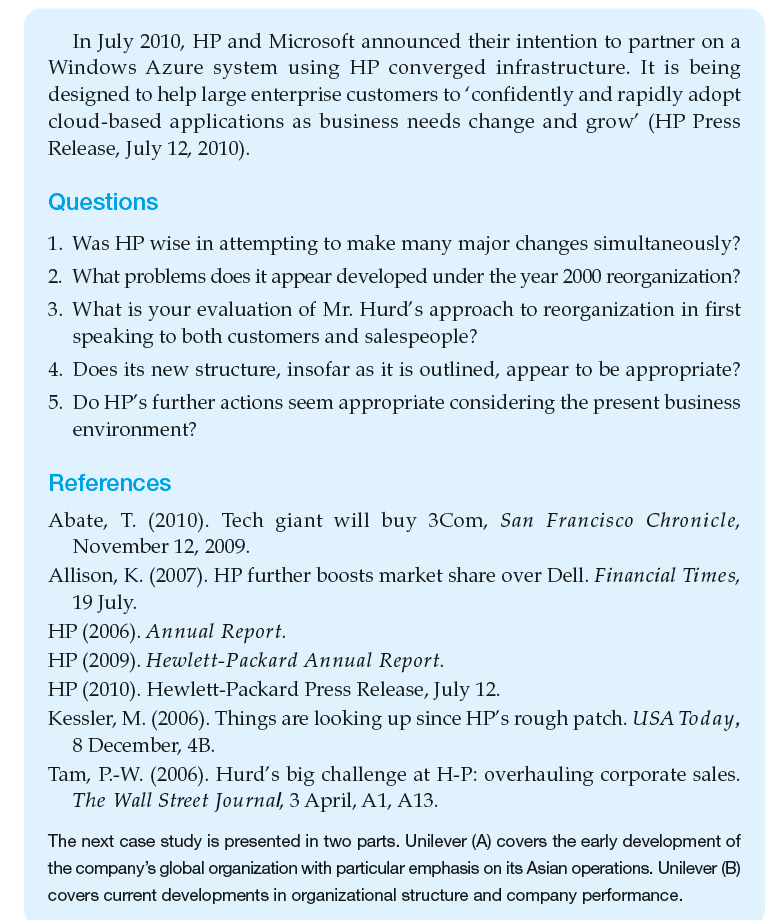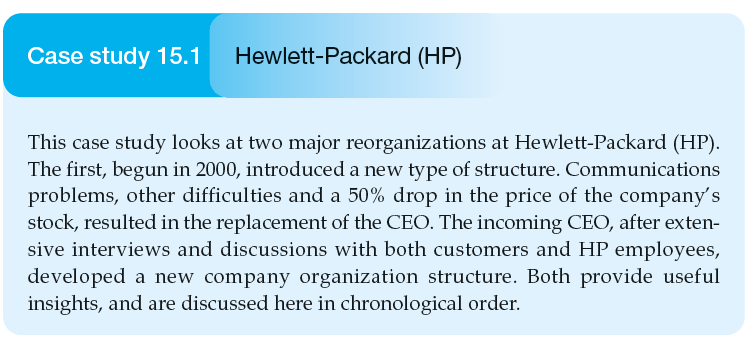I am struggling with 3 case studies that I need for my international business class. Can you please help me understand the text by summarizing each article, listing the important facts, key issues, course of action, and best course of action. That would be greatly appreciated.
The pictures below start with quint Winery ( page 500)
Case study 8.2 inery (This case study was written by Prof. Dr Alfred Joepen, Fachhochschule Aachen, Germany, and Dr Neil Evans. San Francisco State University.) W Michael Quint has recently taken over the family-owned, independent producer of quality wines in Germany' s picturesque Mosel River Valley. With the enthusiastic support of his wife and the continuing support of his parents, he is developing new strategies for the winery to remain successful in the face of increasing competition. These strategies include new products, new pack- aging, and changing emphases in marketing. In all of these developments lV-[r Quint' s objective is to retain the traditional and individual character of the company while increasing productivity. sales, and protability. The rapid growth of the wine market in Japan, with its increasing emphasis on imports from countries around the world, may provide an additional opportunity for Quint Winery. Background The Mose] River Valley has been a producer of high quality wines since Roman times. The river has a series of lowrise dams that provide a broad, smooth surface reecting the summer sunshine on to the shale-laden soil of the valiey's steep slopes. Both the shale and the water itself absorb heat dur- ing the day, releasing it during the night. The result is a micro climate, in the valley alone, ideal for the production of high quality wine grapes. The suit- ability of the region for growing grapes was recognized by the Romans. They introduced viniculture, and wines have been the specialty of the river valley ever since. The steep valley walls require that in some places winches and cables be used to move platforms from which cultivation and harvesting are carried out. This, together with the unsuitability of the climate above the valley walls for growing grapes, has resulted in a pattern of small, independently owned vineyards. In order to make the small-scale operations economically feasible, each family grows its own grapes, makes the wines, bottles them, and does the markeiing themselves. Many small German wineries market their wines directly to consumers. One of the major tools for attraciing customers is the holding of rwine tasting parties\" in a traditional cellar bar close to the winery. For a low package price, the participants have the opportunity to sample a variety of the winery's products along with a steak dinner. The owner of the winery additionally provides a tour of the vineyard and of the winery itself. The participants in such parties often buy bottles of wine on the spot, sometimes become long- term customers, and may recommend the parties to friends. This type of mar- keting approach has worked well in the past for small wineries with very limited funds available for promotion. European integration and the move toward a single market have intensi- ed competition. As a consequence, there are limits in the range of prices the wineries can charge for their wines, even if they are of high quality and unique. A number of wineries have experienced greater than desired carry- over of stock from one year to the next, indicating that additional marketing efforts are required. Strategies Quint Winery specializes in higher quality wines with individuality in taste and avor. The target market is people in the upper middle class, particularly those who appreciate excellent wines and are interested in information about wine, culture, and history. With his own background in the formal study of wine engineering, Michael Quint has a wealth of information that he enjoys sharing with others. The overall strategy is to remain small, and use traditional recipes and processes. However, it is increasing productivity by outsourcing specialized bottling to others that have machinery which Quint cannot economically pur- chase. In adding to its product lines the winery is working with others that have core competencies which cannot be economically developed by Quint. These cooperative activities have allowed the winery to enjoy benefits of being both small and large at the same time. Until the 19905, a regulation issued by an archbishop several centuries ear- lier had prohibited the produciion of red wines in the region. Many Vintners in the area still produce only white wines. However, when the restriction was removed, Quint winery began to produce some red wines whose production proved to be very successful and increased the range of their offerings. It sub- sequently began to produce sparkling wines, based on its white wines, in co operation with a small subcontractor in the village. In the early 2000s it began to produce brandy, again with the assistance of friends who had technical expertise. The company has also been developing and experimenting with new bottle designs that will stress the Quint Winery brand while linking it to the traditions of the house. Quint Winery' 5 major marketing effort is still the holding of traditional wine tasting parties. Michael has added the family imprint by showing re- markable generosity in serving wines and food, and by providing interesting and informative presentations on the history, culture, and processes of wine making. He rmly believes in avoiding any sort of pressure to buy, letting the quality and individuality of the wines inspire a desire to purchase. In an un usual addit'ron to typical service, he also offers to personally deliver the wines to his customers anywhere in Germany. This approach has been working well. People attending the wine tasting events usually buy a number of bottles of the wines, and subsequently rec ommend both the events and the wines to their friends back home. In spite of the increase in customers generated by these activities, additional markets are desired. AJapanese visitor, brought to a wine tasting by German friends, commented on the excellent quality of the wines. She believed that they might prove salable inJapan. if properly marketed, this should allow both increased sales and pos sibly greater margins. An initial step for Michael Quint would be to contact the Japan External Tiade Organization (J ETRO) office in Dusseldorf. Information on marketing in Japan There is much information available from JETRO on the wine market and wine marketing in Japan. Their Japan Trade Directory lists companies that import wine into Japan. The names of the top 10 Japanese importers of wine from Germany and their import volumes are available on the JETRO web page, http:/l www.jetro.go.jp. The JETRO office in Dusseldorf stands ready to assist potential exporters with information, contacts, and opportunities for participation in trade shows in Japan. German organizations that may offer assistance include Deutscher Weinfonds and CMA (the German Agricultural Marketing Board). Wine consumption in Japan has increased substantially during the last 10 years. Ared wine boom occurred in Japan in the late 19905 after researchers associated the drinking of red wine with a lowered incidence of cardiovascu- lar disease. Germany, with its emphasis on the export of white wines, lost market share. Now white wines are growmg in popularity again. JETRO has noted that 'Germany' s wide variety of wines (especially white wines), its unique soils, and its North Country climate are what distinguish German wines from all others' (JETRO Marketing Guidebook for Major Imported Producls, available on the JETRO web page, 2004). There is increased compe- tition in the Japanese wine market from South America, Australia, and the United States. However, there is still a good market for high quality white wines from Germany. There are a number of channels available for selling wine to the Japanese market: direct sales to department stores and mass merchandisers, direct sales to wholesalers and discounters, sales to large trading companies, sales through joint venture projects, and sales inbuLk or in bottles to domestic liquor producers. Anumber of small trading companies, specializing in or emphasiz- ing wine, have opened. These small trading companies supply stores or restaurants which do not import directly, or that wish to supplement their own imports with small amounts from other producers. Together, these changes have substaniialiy increased opportunities for small exporters abroad. The market in Japan has become increasingly sophisticated. Larger depart- ment stores carry a wide variety of wines and may hold special promotions and displays. An increasing number of wine specialty stores have been opened. Several Internet wine shops are now serving the Japanese market, offering a very wide range of wines. According to JETRO, price is a key factor in wine purchase decisions, followed by taste, color, and brand. However, consumers have little interest in poorer quality wine. JETRO offers several types of assistance to prospective exporters in foreign countries. It can help in arranging participation in government-sponsored trade shows of consumer goods. These allow potential foreign exporters to in- troduce their products to a wide range of Japanese consumers and compa- nies. JETRO offices abroad provide information on markets and methods of penetration. JETRO Business Support Centers in Japan provide office space at no charge for up to two months to foreign business people seeking to export to or invest in Japan. The possibility of marketing to Japan Sales to a small Japanese trading firm or directly to a Japanese chain store might offer two advantages to Quint Winery. First, it could provide an outlet for current surplus production. Second, away from the intense competition in the domestic market, it might be possible to obtain a higher price for the unique and high quality wines, particularly if there were some way to inform the Japanese public of the history, romance, and culture of the Mosel River Valley Vintners. It does not appear that Quint Winery could supply a whole container load of their own wine, nor could a smaller chain purchase a whole container load of one Vintner's wine. What should Michael Quint do next? References http:// www.jetro.go.jp JETRO (2001). Japan Trade Directory 20012002, 3-129. JETRO (2001). Pier J: Opportunities in Japan, 'Fine wine club: global offerings for the Japanese dining table,' 3-4 (February). Case study 9.3 (This case study was written by Min Zhao, University of Paris 1 Pantheon-Sorbonne, and Mitsuko Saito Duerr, San Francisco State University.) In 2009, after four decades of rapid growth, China surpassed the US to become the world's largest car market in number of vehicles sold (Waldmeir, 2010a). China is currently the largest single market for Volkswagen AG, the largest automobile manufacturer in Germany (Schafer, 2010). The company has been very successful in China, becoming the market leader there in 1985 and hold- ing that position until at least 2009. Operations in China have been a major contributor to VW's prots over the years. It has benefited greatly from its early entry into automobile manufacturing in China as the Chinese market began to open to foreigners; iis effective adaptation to the business, political, and legal environments; the strength of its commiunent; its development of management and employee training programs for local persoruiel; and changes in its product line as competitive conditions have changed. These policies are discussed in more detail later in this case study. The company continues to increase both production and sales in China. However, its market share has continued to decline, from 58% of the market in 1997 to 18% in 2007 (Chozick and Fairclough, 2007) and under 12% in 2009. This decline in market share resulted from additional foreign companies begin- ning to manufacture there, and existing competitors expanding capacity, to meet the increasing demands of the rapidly growing market. Entrants have included General Motors, Nissan, Hyundai, Daimler, Toyota, BMW, and a number of others in joint ventures with Chinese companies. In 2010, Germany' s BMW made a major share of its prots from operations in China as the demand there for luxury cars, while still comparatively small, is grow- ing rapidly. Chinese companies, in addition to joint ventures with foreign companies, are also directly acquiring technologies from foreign companies in order to develop their own models. Examples include Shanghai Auto acquiring vehicle platforms from the UK's Rover to develop a new line of cars of their own, Beijing Automotive Industry Corp. acquiring vehicle platforms and other technologies from Saab (Dyer, 2010) and China's Greely buying Volvo outright ('Waldmeir, 2010b). In the long run, Chinese automobile com- panies without foreign partners can be expected to increase their market share as they develop vehicles of their own, and bring their quality up to international levels. The Chinese government hopes that it can force consoli- dation among its approximately 25 domestic carmakers to enable one of them to achieve ' global power status within a decade' (Waldmeir 2010a). Volkswagen initially entered the Chinese market as it began to open to foreigners. They first exported vehicles from Europe to China and then, in 1985, began manufacturing in China through a joint venture with Shanghai Automotive Industry Company (SAIC). It quickly became the market leader in the country. Details of the changing business and governmental environments in China, and Volkswagen's strategies to meet these changes are given below. Among the many foreign and domestic companies that have entered the Chinese market, General Motors presents a particularly strong challenge to W. General Motors was another early entrant to marketing in China. It added to its manufacturing capacity when, with a Chinese partner, it purchased bankrupt Daewoo's Chinese factory in 2004. Continuing to add to its manufacturing capacity, General Motors began to challenge W for market leadership in 2007. While Volkswagen was still the market leader in 2009, in 2010 General Motors announced that it will sell over 2 million cars in China during the year (Coy, 2010). If it does so, it would claim market leadership with over 12% of China's estimated sales of 16.5 million units. VW's lower target is to reach sales of 2 million by 2018 (Schafer, 2010). This case discusses: (1) the changing government policies and regula- tions within which Chinese vehicle production was initially developed; (2) the rapid economic growth of the economy and the automobile industry, as the country opened up to foreign investment; (3) the strategies Volkswagen used in entering the Chinese market; and (4) the responses of the company to increasing competition, including but not limited to that of General Motors. Government policies and regulations A motor vehicle industry was started in China in 1955, primarily to produce trucks and military vehicles. After government policies changed in 1978, the economic growth rate increased and production of automobiles expanded. In 1985 the government declared the automotive industry a 'pillar' of industry, targeting it for financial and developmental assistance. The automobile industry was among the first Chinese industries to be backed by a formal state industrial policy. This policy was rst formulated in 1987 and modified in 1994 with emphasis on three points: (1) shift the product mix of the indus try from commercial vehicles to passenger cars; (2) increase economies of scale by restructuring the industry to bring about greater concentration; and (3) obtain technology from abroad by inviting the participation of multina- tional enterprises (MINES). A number of regulations were established in order to ensure the Chinese government 3 continuing overall control, encourage domestic production, and prevent possible abuses. The most important limitations on trade were high tariff and nontari barriers on imports. Government approval of investments is required at central and] or local levels, there are limits on foreign invest- ments, and there are local content requirements. The limit on the percentage of foreign ownership allowed in a company depends upon the categories, types, and models of vehicles or components to be produced, and the size of the investment. Foreign companies planning to build a complete car or any of the three key components of a vehicle (motors, air bags, and ABS) were limited to a maximum of 50% of equity. Foreign investments of over $30 million or involving key car components required approval at the national level by both the State Planning Commis- sion and the Ministry of Foreign Trade and Economic Cooperation. Smaller investments not involving production of key components can be approved at the provincial level. Even with approved projects, barriers may still be encountered at the local level. Remittance of profits may still be difficult. In all arrangements, with companies as well as with government ofcials, time must be taken to develop personal relationships and show the advantages to all groups involved. In order to encourage local production and protect local industry, China had very high tariff barriers, particularly on goods that were viewed as luxuries (such as automobiles). The tariff rate on automobiles was set at 180220% before 1986. The import taxes were as high as 100% on complete vehicles and 60% for parts before 2000. Purchase prices of imported cars were therefore 250300% higher than comparable prices abroad. China also has restrictions regarding the obtaining of licenses to import motor vehicles and parts. Thanks to government market-opening measures, tariffs for automobiles were reduced to 25% by 2006. The tariff rate on other vehicles depends upon the cylinder capacity and ignition features of the vehicle. Import license restrictions and quotas were phased out by 2005. The government sets the duty rates on locally assembled vehicles accord- ing to the percentage of the value of locally made parts. In order to cut down on the nation's pollution problems, China's authorities give foreign car makers more favorable treatment if they bring in cars with advanced ecological tech- nologies, such as catalytic converters, electronic fuel injection, and computer- controlled ignitions. Economic growth and the development of the automobile industry The overall Chinese economy began to expand after it opened up to foreign companies in the early 19805, with growth averaging 7% per year during that decade. China joined the WTO in 2001. This resulted in the gradual liberalizing of trade and phased increases in the rights of foreign corporations regarding investment limits, property rights, and the ability to engage in distribution, finance, etc. For the first time carmakers could set prices and introduce new models without obtaining formal government approval. Since then, foreign investment exports, and GDP have grown even more rapidly, making China's GDP growth rate the highest in the world. China has become one of the world's largest investment destinations, and the automobile industry has become one of the largest beneficiaries of that investment. Automobile sales to private parties have been rising faster than per capita income. This is partly due to a growth in the number of people in the middle and upper classes, and the recognition of the convenience, usefulness, and status conveyed by owning an automobile. In 1990, sales of automobiles and trucks together totaled less than half a million. By 2009, the number had increased to 13.6 million (Nissan Production in China to Rise, 2010). The boom in the Chinese automobile market has attracted investment from almost all of the world's automobile manufacturers. With sales stagnant or growing only slowly in their home markets, China has been viewed as a major source of growth. The latecomers to the market, including Toyota, Nissan, Hyundai, and BMW now plan to make major additional investments in China. Seven of the world's ten largest parts suppliers have also estab- lished operations in China. There is a danger that the flood of investment may result in excess capacity. Automobile prices have already been declining as competition increases. The automotive industry in China remains fragmented with over 3000 parts suppliers and many final assemblers. The Chinese goven'lment has des- ignated seven companies as 'key firms' targeted for expansion. It encouraged these firms to pursue alliances with foreign original equipment manufacturers (OEMs), while limiting small new investments. The automobile industry is still dominated by joint ventures of foreign and Chinese companies. One of the Chinese government' 5 objectives is to have at least one of its Chinese companies become a world-class manufacturer capable of exporting large numbers of vehicles. Changing strategies, VW and GM In spite of the high duty rates and other restrictions on imports, there was an increase in the demand for foreign automobiles in the growing market for vehicles in the 1980s. It was apparent, however, that importing would con- tinue to be restricted. Thus achieving substantial sales in China would require an investment in manufacturing, at least in the assembly of vehicles, in China. The impediments and risks seemed high as government attitudes, policies and regulations were not always clear and could be changed abruptly. The division of authority and responsibility between the national, regional, and local governments was evolving, and not always transparent. Continued growth of the market was not assured. Volkswagen had been able to export some automobiles to China and felt condent that they could sell enough of their least expensive models to justify undertaking local manufacturing. Because of the limits on foreign ownership on substantial investments, VW needed to find a domestic partner. The first step in the process was to develop relationships with government ofcials at all levels and with a potential partner. The Chinese emphasis on rst develop- ing trust, and the necessity of understanding the nontransparent but critically important informal relationships that influence both government and busi- ness actions, required both time and patience. Volkswagen's rst joint venture was with the General Corporation of Au- tomobiles and Tractors of Shanghai, now the Shanghai Automobile Industrial Co. (SAIC). The joint venture, Shanghai VW (SVW), was formed in 1984 and started production in 1985. SAIC was the second largest vehicle manufacturer in China, one of the 'key rms' targeted by the national government for growth and under the control of the local government. Its location in Shang- hai put it in the main industrial and business center of the country. SAIC had an excellent indusirial network for supplying parts. SVW invited the Bank of China to join the joint venture to ensure the ability to make foreign currency payments. The Chinese National Automobile Industry Co. (CNAIC), a firm conirolled by the national government, became the fourth partner due to the importance of tangible and intangible support from the central government. Zhu Ron-i, the mayor of Shanghai from 1988 to 1991, set up a taxi com- pany for the municipality that would be equipped with Volkswagen San- tanas. VW moved its assembly lines for Santanas from South Africa to Shanghai. The efforts were mutually beneficial as sales rose for Shanghai VW the local government encouraged foreign parts suppliers to establish joint ventures in China, more industrial workers were employed in the area, and SVW achieved an 85% local content rate by 1993. Volkswagen's second joint venture was with First Automobile Work Group (FAW), forming FAW W in 1991. FAW is under the direct control of the central government. The FAW VW joint venture was formed to produce the VW Jetta and the Audi. The increasing competition in car production in China, and China's entry into the WTO, have caused Volkswagen to modify some of the strategies it adopted when it rst began manufacturing in China. These include changes in manufacturing, changes in the product line and model introductions, and changes in marketing management. Foreign automobile manufacturers entering China typically began by assembling cars from a set of imported components, with little or no use of lo- cally made parts. They sometimes continued this policy for a number of years. Shanghai VW, with assistance from the local government, quickly adopted a program to increase the percentage of parts made locally. By 2004 Volkswagen had initiated the establishment of 160 joint ventures between foreign and Chinese suppliers of parts, approximately 100 license and know- how agreements, and 250 toll and equipment agreements. VW modernized its production line and began to make its Passat model vehicle at the Shanghai facility in 2000, maintaining the same technical stan- dard as that used in Europe (including processes such as laser welding). In 2002, the company successfully launched its Polo model car in Shanghai. Productivity was improved by employee training programs from the beginning of the joint ventures, and by demonstrating to local employees that there were opportunities for advancement. In 1998 VW instituted a three-year program in which 40 key people from all sectors, including the factory lines, were sent to Germany. Since then, more than 1000 others have left Shanghai for various types of training in Germany. The joint venture is working hard to keep up with growing demand. Of the three production lines in Shanghai, two are on a double shift and one is on three shifts. The company has also spent $120 million on a new technology center. The rate of introduction of new models was greatly increased. For the first 10 years of SVW in China, it produced only one model, the Santana. In 1995, the more modem Santana 2000 was launched. Two other models, the ]etta and the Audi, were put into production at FAW VW plants. As the time of entry to the \"TO approached, VW began production of PassaLs at its Shanghai plant. Since then, Volkswagen has introduced a number of new models. Most of them have appeared on the Chinese markets within a few months of their European and US launches. The choice of color combinations has also been expanded. While Volkswagen's main focus in China remains on manufacturing locally, it still imports specialized models that cannot be sold in sufcient numbers to justify local production. Examples include Volkswagen's super luxury Phantom and a Chinese version of its luxury SUV, the Touareg, intro- duced at the Volkswagen Forum Beijing in 2004. Marketing is another area where changes have been made. In the 1980s, with market demand uncertain and Volkswagen desiring to concentrate on manufacturing, the joint venture agreement stated that the sales of assembled cars would be the responsibility of SAIC. With the expansion of the market VW has developed its own sales network under its control. VW has intro- duced a version of an incentive system for dealers that it uses in Europe. The system uses a computerized network that allows call center managers to monitor how dealers follow up on customer inquiries. Volkswagen is consid ering entering into car purchase financing. The company is also increasingly engaged in promotional activities. In 2004 it sponsored a four-week Volkswagen Forum Beijing including a Volkswagen Masters-China golf tournament; a Women's Day Celebration; activities featur- ing German and Chinese artists, musicians and actors; and a Tree Planting Day. At the Beijing Auto Show that opened in April, 2010, Volkswagen became the first automobile company ever to sponsor a whole pavilion. The foremost challenge to Volkswagen's market leadership has come from General Motors. GM was also an early entrant to the Chinese market. It suc- cessfully established Buick as a luxury brand, including such features as con- trol of the audio system from the back seat since owners of luxury vehicles had drivers who would not be expected to control the radio or CDs. It added productive capacity by purchasing, with a Chinese partner, the Chinese fac- tory of bankrupt Daewoo. GM introduced lower-priced cars and made con- tinuing improvements in productivity. In 2010, GM announced that it would sell over 2 million cars during the year (Waldmeir, 2010a). That would put it in first place, ahead of Volkswagen that had not planned to increase sales to that level until 2018 (Schafer, 2010). On March 7, 2010, Volkswagen responded to the latest challenges by increas ing its budget for investment in China by $2.1 billion. Most of the additional money will be used to build two new plants. This will bring its total investment fund for China to $7.8 billion for the coming six years (Schafer, 2010). References Chozick, A. and Fairclough, G. (2007). Honda to create a brand for China market, The Nikkei Weekly, 19 July, 10. Coy, P. (2010). Appetite for imports supports imbalance, San Francisco Chronicle, 10 May, D4. Dyer, G. (2010). Chance to shine for home brand, Financial Times, 22 April, 18. Nissan production in China to rise (2010). Financial Times, 24-25 April, 10. Schafer, D. (2010). VW boosts budget by Euro 1.6bn, Financial Times, 27 April, 15. Waldmeir, P. (2010a). Chinese aim to be king of the road, Financial Times, 22 April, 18. Waldmeir, P. (2010b). Chinese carmakers in great leap forward to luxury, Financial Times, 24-25 April, 10.A largely unsuccessful reorganization In 2000, CEO Carly Fiorina led HewlettPackard (HP) in a major reorganiza tion plan that, among other things, was designed to provide sales growth of 20% starting in the year 2002. The intent of this action was to transform all aspects of HP at once, without any precedent that it would work for a com pany as large and complex as HP. This meant that strategy, structure, culture, and compensation would be affected everything from how to spark innova tion to how to streamline intemal processes. The 'new' HP was to excel at shortterm execution while pursuing long-term visions that create new mar kets. It should increase sales and prots together rather than sacrice one to gain the other. HP was to emphasize technology, software, and consulting in every aspect of computing. The key to all this was a complete overhaul of the organization structure from one based on products to a matrix or mixed organization. In the past, HP was essentially a confederation of 83 autonomous product units, each with prot responsibility, reporting through four groups: (1) home PCs, handhelds, laptops; (2) scanners, laser printers, printer paper; (3) ink cartridges, digital cameras, home printers; and (4) consulting, security software, unix servers. The company was organized into two 'backend' divisions, one developing printers, scanners, etc. and the other computers. These reported to 'front-end' groups that marketed and sold HP's products (corporate sales and consumer sales). The organization was structured as shown in Figure 15.5. Strategy Council """" ' "* Executive Council Corporate Sales Consumer Sales {antend} Materiel) \"-: K 2' .4 Printers C emputars 5": (back and) (back and) :5 '2. 4 a 31 i i 9 Gross-Company Initiatives Digital imaging,WirelIss services, Comm-rciul printing Teams including both back and and from and people Key: p Authority ------ 5 Ideas and innovations \"up Recommendations "3- Products Ind intormeliun The functions of the major units were: 1 Strategy Council. Nine managers who advise the Executive Council on allocating money and people to growth industries. 2 Executive Council. Eight top managers, including heads of the back- and front-end groups. 3 Corporate Sales. Sell technology solutions to corporate clients. Keep back- end units abreast of what is hot. 4 Consumer Sales. Sell consumer gear. Let back-end know of must-have prod ucis and features. 5 Printers. Build new printing and imaging products to ensure HP's long- tenn growth. 6 Computers. Focus on future success by making computers that companies and consumers want, with sales input from front end. 7 Cross-company Initiatives. Personnel from back and front-end groups work together to identify new markets that will create growth. It was not clear whether such an organization would work as there was no 'n-rodel' to look to. Some expected benets were happier customers, increased sales, producls could be sold as solutions to problems, and nancial exibility. Concerning the latter, with all corporate sales under one roof, HP could meas- ure the total value of a customer. There were some risks, however. With so much being made and sold by just four units, executives could be over- whelmed by their duties. There could be poorer execution as the front-end and back-end units would coordinate their plans with such a time schedule that quick response to changes would not be possible. Sinoe prot and loss respon- sibility is shared between the front- and back-end groups, no one person would be accountable. Finally, there would be fewer controls over expenditures. This clearly was an ambitious direction being taken by HP. Problems did develop, with large corporate customers later complaining that they didn't know whom to call at HP because of the confusion caused by the several layers of management. Some complained that HP sales people in Europe and the United States gave different prices in quotations. Ms. Fiorina made several changes in the organization's sales foroe over time, but the prob- lems were not solved. The Board of Directors became divided over the pur- chase of Compaq Computer Company that she was pushing for. After Compaq was acquired in 2002, the sales force became increasingly less effective. Eleven layers of management stood between the CEO and a customer (Tarn, 2006). Ms. Fiorina was replaced as CEO by Mark Hurd in 2005. Some of the changes brought about by Ms. Fiorina, such as the purchase of Compaq Com- puter had longer-range benets as it paved the way for HP to overtake and surpass Dell in personal computer sales (Kessler, 2006; Allison, 2007). How- ever, sales when she left were at just about the same level as when she had arrived over ve years earlier. The company had lost money in 2002, but both sales and earnings have increased since then (HP, 2006). Mr. Hurd's biggest challenge was in increasing effectiveness in the sales force. In his first two months on the job, he talked with 400 corporate cus tomers to find out how they viewed HP's sales organization and received many complaints. He also interviewed HP salespeople, learning about their problems with their company' s bureaucracy Mr. Hurd then led in the devel- opment of a new company organization structure in which the business units within the company were given control over and responsibility for sales within their business units. Approximately 10% of the work force, over 14,500 employees, was laid off. Compensation of salespersons was changed so that greater contributions to company profitability would lead to more pay. The company also changed its marketing structure so that each corporate cus tomer has one contact salesperson at HP (Tarn, 2006). In its overall organiza- tion structure, it removed three layers of management. The second reorganization, and adjustments By the end of 2006, HP had been reorganized into three globally structured business groups: Imaging and Printing (IPG), Personal Systems (PSG), and Technology Systems (TSG). Each of these groups had a strategy for driving market leadership drawing upon research and development, sales, market- ing, and operations (HP, 2006). The company has continued to enjoy growth in sales, with approximately 64% of its revenues coming from outside the US, and in prots. A small de crease in fiscal 2009, because of the recession, still left both sales and profits above the 2007 level (HP, 2009). The Personal Systems Group has improved the eiciency of the industry' s largest PC supply chain and tens of thousands of resellers and retailers around the world, maintaining its position as the leader in PC sales and becoming the leader in the US enterprise market. The Imaging and Printing Group was the most badly hit by the recession, but is gaining in retail photo kiosks and using its technology to gain from the shifting from analog to digital prinng. HP sees a future of converged infrastructure (see page 2 of the CEO letter in HP's 2009 Annual Report). HP believes that it is the best positioned to drive this evolution and deliver on its potential. In the continually evolving business environment, Technology Systems was rebranded as HP Enterprise Business covering software, servers and storage. HP also recognized additional opportunities for complementary acquisitions and partnerships. It acquired and integrated EDS in Business Services (within HP Enterprise Business). This provided new customers, improved customer satisfaction, and provided an additional revenue stream. HP then acquired 3Com Communications for its outstanding technology in computer networking, for $2.7 billion, in order to expand its sales in that area. It came at a time when all large selle of technology wanted to become a sort of onestop shop for their corporate computing customers (Abate, 2009). In July 2010, HP and Microsoft announced their intention to partner on a Windows Azure system using HP converged infrastructure. It is being designed to help large enterprise customers to 'confidently and rapidly adopt cloud-based applications as business needs change and grow' (HP Press Release, July 12, 2010). Questions 1. Was HP wise in attempting to make many major changes simultaneously? 2. What problems does it appear developed under the year 2000 reorganization? 3. What is your evaluation of Mr. Hurd's approach to reorganization in first speaking to both customers and salespeople? 4. Does its new structure, insofar as it is outlined, appear to be appropriate? 5. Do HP's further actions seem appropriate considering the present business environment? References Abate, T. (2010). Tech giant will buy 3Com, San Francisco Chronicle, November 12, 2009. Allison, K. (2007). HP further boosts market share over Dell. Financial Times, 19 July. HP (2006). Annual Report. HP (2009). Hewlett-packard Annual Report. HP (2010). Hewlett-packard Press Release, July 12. Kessler, M. (2006). Things are looking up since HP's rough patch. USA Today, 8 December, 4B. Tam, P.-W. (2006). Hurd's big challenge at H-P: overhauling corporate sales. The Wall Street Journal, 3 April, Al, A13. The next case study is presented in two parts. Unilever (A) covers the early development of the company's global organization with particular emphasis on its Asian operations. Unilever (B) covers current developments in organizational structure and company performance.Case study 15.1 This case study looks at two major reorganizations at Hewlett-Packard (HP) The first, begun in 2000, introduced a new type of structure. Communications problems, other difculties and a. 50% drop in the price of the company' s stock, resulted in the replacement of the CEO' The incoming CEO, after exten- sive interviews and discussions with both customers and HP employees, developed a new company organization structure. Both provide useful insights, and are discussed here in chronological order
